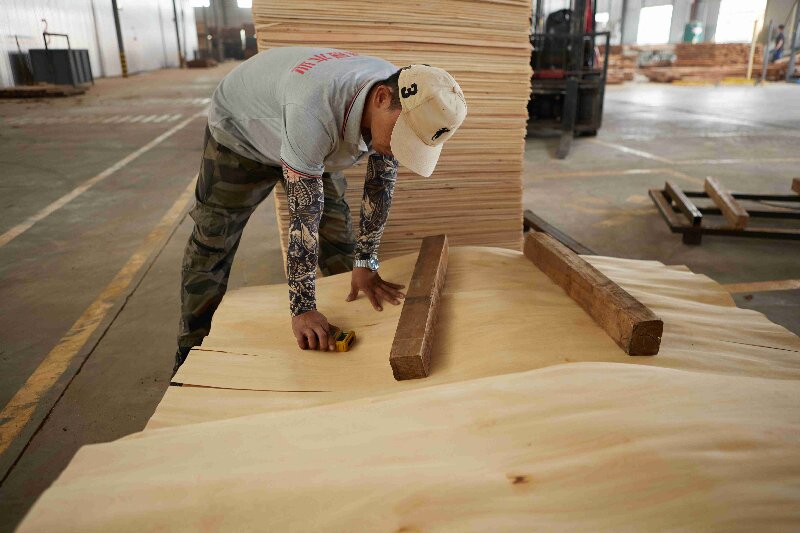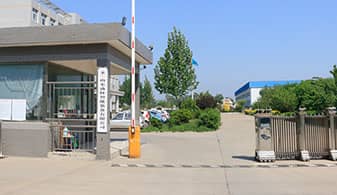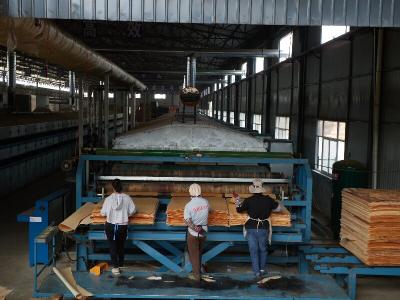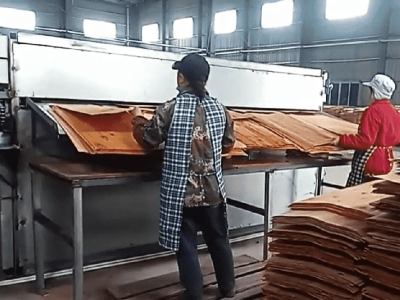The Unseen Axis of Efficiency: Why Perpendicular Grain Alignment is the Non-Negotiable Rule in Veneer Drying
SPRINGFIELD, OREGON – In the vast, humming landscape of a modern veneer production facility, amidst the roar of lathes and the scent of fresh-cut wood, a seemingly minor detail at the dryer feed conveyor can make the difference between premium profitability and catastrophic loss. This detail is the orientation of the wood grain relative to the mammoth machine that will desiccate it: the veneer dryer. The rule is deceptively simple, drummed into the head of every new operator: the grain of the veneer must enter the dryer perpendicular to the axis of the rollers. Yet, the depth of reasoning behind this rule encompasses a fascinating interplay of physics, material science, and bottom-line business acumen.
While automation and precision engineering have revolutionized the wood-based panels industry, this fundamental principle remains as relevant today as it was a century ago. Ignoring it is not an option for any manufacturer serious about quality, yield, and operational efficiency. This article explores the multifaceted reasons why perpendicular grain alignment is the cornerstone of effective veneer drying.
Part 1: The Core Principle – A Clash of Forces and Fibers
At its heart, wood is an anisotropic material. Its properties—including strength, dimensional stability, and permeability—vary dramatically depending on the direction relative to the grain. Veneer, being a thin sheet peeled or sliced from a log, magnifies these directional characteristics.
When veneer enters a multi-deck, roller-equipped dryer, it is subjected to a brutal environment: intense heat, rapidly moving air, and mechanical conveyance. The rollers are not just passive guides; they are the driving force that pulls the flexible, often floppy, sheets through the long, heated chamber.
1.1 The Tensile Strength Disparity:
Wood fibers are naturally bound together along their length. This gives wood immense tensile strength along the grain (longitudinally). One can easily tear a piece of paper along a perforated line; similarly, wood veneer has a natural "perforation" along the grain lines. Its tensile strength across the grain (tangentially and radially) is a mere fraction of its longitudinal strength.
If the veneer is fed with the grain parallel to the rollers, the pulling force of the rollers is applied directly across this weak axis. The result is predictable and devastating: the sheet stretches, then ruptures. It tears like a piece of fabric, creating a "web break" inside the dryer. This not only destroys that particular sheet but can also cause a domino effect, jamming the machine and requiring a costly, time-consuming shutdown to clear the debris.
However, when the grain is perpendicular to the rollers, the immense tensile strength of the wood is aligned with the direction of pull. The strong, long cellulose fibers act like thousands of microscopic cables, allowing the sheet to withstand the significant tension forces required to pull it through the entire length of the dryer without breaking. This is the primary and most immediate reason for the rule: to prevent catastrophic tearing and ensure continuous production.
1.2 The Shrinkage Conundrum:
As wood loses moisture, it shrinks. But it does not shrink uniformly. Tangential shrinkage (parallel to the growth rings) is roughly twice as great as radial shrinkage (across the growth rings). Longitudinal shrinkage along the grain is negligible, typically less than 0.1%. In veneer, this translates to significant shrinkage across the width of the sheet and minimal shrinkage along its length.
Consider a sheet of veneer entering the dryer:
With Perpendicular Grain: The width of the sheet (the direction of significant shrinkage) is unconstrained. It is free to shrink between the rollers without hindrance. The length, running with the grain, remains virtually unchanged. The sheet maintains its integrity.
With Parallel Grain: The width of the sheet now runs with the grain and sees little shrinkage. However, the length, which is now across the grain, is the dimension that wants to shrink dramatically. But it cannot. It is being gripped and pulled taut by the rollers. This creates immense internal stress, leading to two likely failure modes:
Cracking: The stress exceeds the wood's strength across the grain, causing checks and splits to form along the length of the sheet.
Warping: The stress is relieved unevenly, causing the veneer to cup, bow, or twist into unusable shapes as it dries under tension.
Dr. Evelyn Reed, a materials scientist at the National Timber Institute, explains: "You are essentially putting the wood in a state of mechanical contradiction. Its cellular structure is programmed to contract in one dimension, while your machinery is physically preventing it. The wood will always lose that battle, resulting in defects that render the material unfit for its final application, whether it be furniture, flooring, or structural panels."
Part 2: Beyond the Basics – The Ripple Effects on Quality and Economics
The prevention of tearing is just the entry fee. The perpendicular alignment has profound downstream effects on the entire manufacturing value chain.
2.1 Optimized Drying Uniformity and Energy Efficiency:
A modern jet dryer works by forcing high-velocity hot air through nozzles onto the surface of the veneer. This air not only heats the wood but also carries away the evaporated moisture. When the veneer is flat and stable—as it is when aligned correctly—the air impingement is even across the entire sheet. This promotes uniform moisture content (MC) from the center to the edges and from end to end.
Misaligned grain leading to warping creates pockets of stagnant air and areas where the jet air cannot effectively strike the surface. These areas dry more slowly, resulting in a sheet with high MC spots and over-dried, brittle spots. Non-uniform MC in the final veneer is the arch-nemesis of the subsequent pressing process, leading to delamination, blowouts, and weak spots in the finished plywood or LVL.
Furthermore, consistent, flat sheets allow for optimized dryer settings. The line speed, temperature, and air velocity can be fine-tuned for a specific species and thickness. When the process is stable, the dryer operates at peak thermal efficiency. Inconsistent feeding due to grain misalignment forces operators to slow down the line or increase temperatures to compensate for the poorly drying sheets, driving up energy costs—one of the largest operational expenses in a veneer mill.
2.2 Maximizing Yield and Product Value:
Every tear, check, or warped sheet is a direct loss of raw material. A single web break can destroy a sheet that represents valuable square footage of lumber. More insidiously, the small edge cracks and splits that result from misalignment force downstream trimming operations to remove more material, reducing the overall yield from each log.
In high-value applications like architectural paneling or face veneers for fine furniture, a single crack or blemish can downgrade an entire sheet from "Premium" to "Utility" grade, slashing its market value by 50% or more. The precision of perpendicular feeding is, therefore, a direct contributor to the mill's yield percentage and average sales price.
3.3 Enhancing Downstream Manufacturing:
The benefits of properly dried, flat, and crack-free veneer extend far beyond the drying department.
Clipping and Splicing: In the clipping line, where dried veneer is cut to size, flat sheets are easier to handle and cut accurately. Sheets with wavy edges or splits jam automated equipment and require more manual intervention.
Layup and Pressing: This is where the payoff is most evident. In the layup process for plywood, uniform veneer sheets ensure consistent glue spread and a flat, stable "mat" ready for the hot press. When veneers of varying MC or with hidden internal stresses are pressed together, the resulting panel can suffer from warping, springback, or internal failures after it leaves the press. A panel made from perfectly aligned and dried veneer will have superior dimensional stability and mechanical properties.
Part 3: Implementing the Principle – Technology and Training
Knowing the "why" is useless without the "how." Ensuring consistent perpendicular grain alignment is a challenge that mills address through a combination of technology and rigorous operator training.
3.1 The Role of Automation and Scanning:
Progressive mills are increasingly turning to automated feeding systems equipped with advanced vision technology. High-resolution line-scan cameras are positioned just before the dryer infeed. These cameras instantly identify the grain direction of each incoming sheet.
This data is fed to a programmable logic controller (PLC) that can command one of two systems:
A Rotating Infeed Conveyor: The entire conveyor table can rotate the sheet a few degrees left or right to square the grain perfectly with the rollers before it is picked up.
Guided Nudger Arms: Pneumatic arms gently tap the edges of the sheet as it travels on the conveyor, minutely adjusting its orientation until it is perpendicular.
"These systems have taken the guesswork and human error out of the equation," says Mark Chen, an engineering manager at a leading dryer manufacturer. "They operate at line speeds impossible for a human to match, making thousands of micro-adjustments per shift. The return on investment is quickly realized through a near-zero web break rate and a demonstrable jump in final product quality."
3.2 The Human Element:
Even with the best technology, the operator remains crucial. Training programs must emphasize not just the rule, but the reasons. An operator who understands that a lazily fed sheet directly causes panel delamination and customer complaints is more likely to be vigilant.
"We show them the broken sheets from the jam," says Sarah Pendleton, a plant manager with two decades of experience. "We show them the energy consumption graphs when the dryer has to cycle up and down. We connect their action at the infeed to the quality of the product leaving the shipping dock. When they see that chain of events, it stops being just a procedure and becomes a point of professional pride."
Conclusion: A Principle Forged in the Fibers of the Industry
The mandate for feeding veneer with the grain perpendicular to the dryer rollers is far more than a quaint industry tradition. It is a fundamental law dictated by the very nature of wood itself. It is a practice that sits at the critical intersection of physics, engineering, and economics.
From preventing immediate mechanical failure to ensuring the long-term integrity of a multi-million dollar panel line, this single, disciplined action reverberates through the entire manufacturing process. It conserves energy, maximizes the value extracted from every harvested tree, and ultimately, determines the strength and beauty of the wood products that end up in our homes, offices, and infrastructure.
In an age of digital transformation and smart factories, it is a powerful reminder that the deepest wisdom often lies in respecting the inherent properties of the natural materials we work with. For the veneer industry, that wisdom will always be oriented in one direction: perpendicular to the roll.






